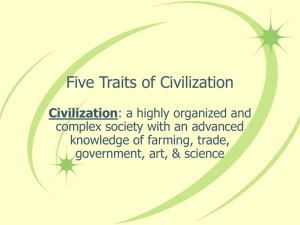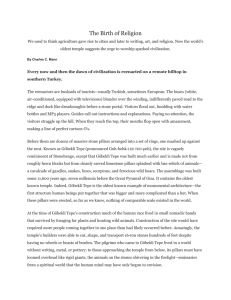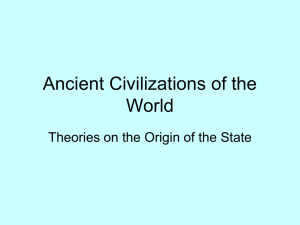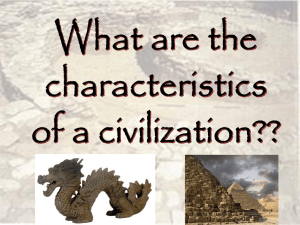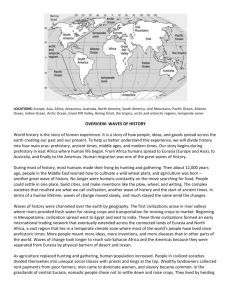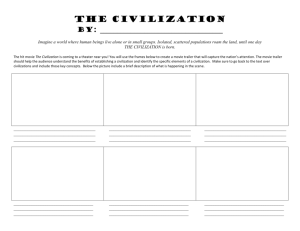Origins of Civilization
advertisement
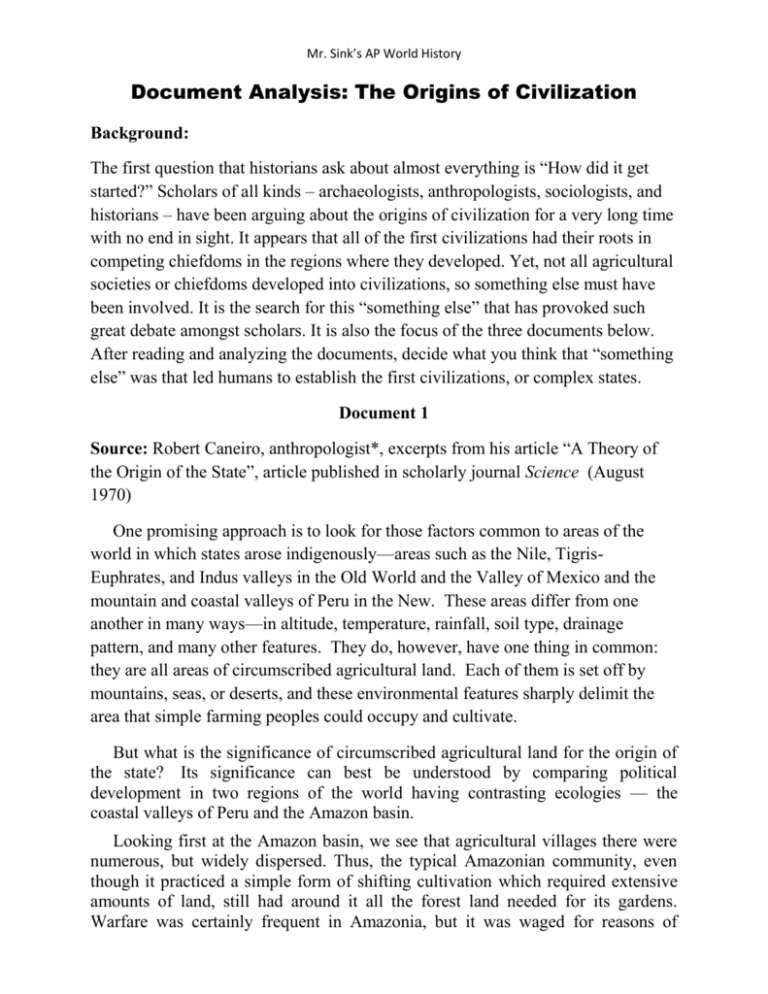
Mr. Sink’s AP World History Document Analysis: The Origins of Civilization Background: The first question that historians ask about almost everything is “How did it get started?” Scholars of all kinds – archaeologists, anthropologists, sociologists, and historians – have been arguing about the origins of civilization for a very long time with no end in sight. It appears that all of the first civilizations had their roots in competing chiefdoms in the regions where they developed. Yet, not all agricultural societies or chiefdoms developed into civilizations, so something else must have been involved. It is the search for this “something else” that has provoked such great debate amongst scholars. It is also the focus of the three documents below. After reading and analyzing the documents, decide what you think that “something else” was that led humans to establish the first civilizations, or complex states. Document 1 Source: Robert Caneiro, anthropologist*, excerpts from his article “A Theory of the Origin of the State”, article published in scholarly journal Science (August 1970) One promising approach is to look for those factors common to areas of the world in which states arose indigenously—areas such as the Nile, TigrisEuphrates, and Indus valleys in the Old World and the Valley of Mexico and the mountain and coastal valleys of Peru in the New. These areas differ from one another in many ways—in altitude, temperature, rainfall, soil type, drainage pattern, and many other features. They do, however, have one thing in common: they are all areas of circumscribed agricultural land. Each of them is set off by mountains, seas, or deserts, and these environmental features sharply delimit the area that simple farming peoples could occupy and cultivate. But what is the significance of circumscribed agricultural land for the origin of the state? Its significance can best be understood by comparing political development in two regions of the world having contrasting ecologies — the coastal valleys of Peru and the Amazon basin. Looking first at the Amazon basin, we see that agricultural villages there were numerous, but widely dispersed. Thus, the typical Amazonian community, even though it practiced a simple form of shifting cultivation which required extensive amounts of land, still had around it all the forest land needed for its gardens. Warfare was certainly frequent in Amazonia, but it was waged for reasons of revenge, the taking of women, the gaining of personal prestige, and motives of a similar sort. There being no shortage of land, there was, by and large, no warfare over land. The consequences of the type of warfare that did occur in Amazonia were as follows. A defeated group was not, as a rule, driven from its land. Nor did the victor make any real effort to subject the vanquished, or to exact tribute from him. This would have been difficult to accomplish in any case, since there was no effective way to prevent the losers from fleeing to a distant part of the forest. With only a very few exceptions, noted below, there was no tendency in Amazonia for villages to be held in place and to combine into larger political units. In marked contrast to the situation in Amazonia were the events that transpired in the narrow valleys of the Peruvian coast. However, instead of being scattered over a vast expanse of rain forest as they were in Amazonia, villages here were confined to some 78 short and narrow valleys. With increasing pressure of human population on the land, however, the major incentive for war changed from a desire for revenge to a need to acquire land. And, as the causes of war became predominantly economic, the frequency, intensity, and importance of war increased. In Peru, the mountains, the desert, and the sea—to say nothing of neighboring villages—blocked escape in every direction. A village defeated in war thus faced political subordination to the victor. This subordination generally entailed at least the payment of a tribute or tax in kind, which the defeated village could provide only by producing more food than it had produced before. Political evolution was attaining the level of the chiefdom. As land shortages continued and became even more acute, so did warfare. Now, however, the competing units were no longer small villages but, often, large chiefdoms. From this point on, through the conquest of chiefdom by chiefdom, the size of political units increased at a progressively faster rate. Naturally, as autonomous political units increased in size, they decreased in number, with the result that an entire valley was eventually unified under the banner of its strongest chiefdom. The political unit thus formed was undoubtedly sufficiently centralized and complex to warrant being called a state. *NOTE: An anthropologist is a scholar who studies early human beings and the way societies and cultures originate and are organized. Document 2 Source: Jared Diamond, ethnobiologist*, Guns, Germs and Steel (book), 1999 Plant and animal domestication meant much more food and hence much denser human populations. The resulting food surpluses, and (in some areas) the animal-based means of transporting those surpluses, were a prerequisite for the development of a settled, politically centralized, socially stratified, economically complex, technologically innovative societies. Hence the availability of domestic plants and animals ultimately explains why empires, literacy, and steel weapons developed earliest in Eurasia and later, or not at all, on other continents. The military uses of horses and camels, and the killing power of animal-derived germs, complete the list of major links between food production and conquest . . . Eurasian peoples happened to inherit many more species of domesticable large wild mammalian herbivores than did people of the other continents. That outcome, with all of its momentous advantages for Eurasian societies, stemmed from three basic facts of mammalian geography, history and biology. First, Eurasia, benefiting its large area and ecological diversity, started out with the most candidates. Second Australia and the Americas, but not Eurasia or Africa, lost most of their candidates in a massive wave of late-Pleistocene extinctions . . .Finally, a higher percentage of the surviving candidates proved suitable for domestication on Eurasia than on other continents. *NOTE: An ethnobiologist is a scientist that studies the dynamic relationships between peoples, biota**, and environments, from the distant past to the immediate present. **NOTE: Biota is the animal and plant life of a particular region, habitat, or geological period. Document #3 Source: Charles C. Mann, journalist, excerpts from article “Birth of Religion”, National Geographic , June 2011 Every now and then the dawn of civilization is reenacted on a remote hilltop in southern Turkey. The reenactors are busloads of tourists—usually Turkish, sometimes European…Before them are dozens of massive stone pillars arranged into a set of rings, one mashed up against the next. Known as Göbekli Tepe (pronounced Guh-behk-LEE TEH-peh), the site is vaguely reminiscent of Stonehenge, except that Göbekli Tepe was built much earlier and is made not from roughly hewn blocks but from cleanly carved limestone pillars splashed with basreliefs of animals—a cavalcade of gazelles, snakes, foxes, scorpions, and ferocious wild boars. The assemblage was built some 11,600 years ago, seven millennia before the Great Pyramid of Giza. It contains the oldest known temple. Indeed, Göbekli Tepe is the oldest known example of monumental architecture—the first structure human beings put together that was bigger and more complicated than a hut. When these pillars were erected, so far as we know, nothing of comparable scale existed in the world. At the time of Göbekli Tepe's construction much of the human race lived in small nomadic bands that survived by foraging for plants and hunting wild animals. Construction of the site would have required more people coming together in one place than had likely occurred before. Amazingly, the temple's builders were able to cut, shape, and transport 16-ton stones hundreds of feet despite having no wheels or beasts of burden. …Most of the world's great religious centers, past and present, have been destinations for pilgrimages—think of the Vatican, Mecca, Jerusalem, Bodh Gaya (where Buddha was enlightened), or Cahokia (the enormous Native American complex near St. Louis). They are monuments for spiritual travelers, who often came great distances, to gawk at and be stirred by. Göbekli Tepe may be the first of all of them, the beginning of a pattern. What it suggests, at least to the archaeologists working there, is that the human sense of the sacred—and the human love of a good spectacle—may have given rise to civilization itself. … [Archaeologist Klaus] Schmidt speculates that foragers living within a hundred-mile radius of Göbekli Tepe created the temple as a holy place to gather and meet, perhaps bringing gifts and tributes to its priests and craftspeople. Some kind of social organization would have been necessary not only to build it but also to deal with the crowds it attracted. Surely there were feasts; Schmidt has uncovered stone basins that could have been used for beer…Over time, Schmidt believes, the need to acquire sufficient food for those who worked and gathered for ceremonies at Göbekli Tepe may have led to the intensive cultivation of wild cereals and the creation of some of the first domestic strains... In other words, the turn to agriculture celebrated by V. Gordon Childe may have been the result of a need that runs deep in the human psyche, a hunger that still moves people today to travel the globe in search of awe-inspiring sights.
